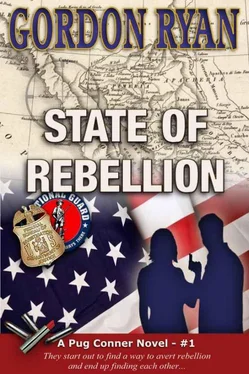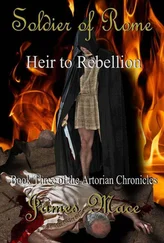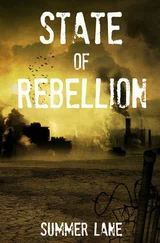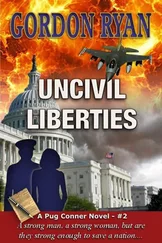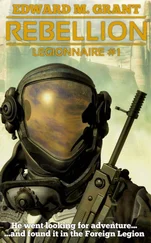Gordon Ryan - State of Rebellion
Здесь есть возможность читать онлайн «Gordon Ryan - State of Rebellion» весь текст электронной книги совершенно бесплатно (целиком полную версию без сокращений). В некоторых случаях можно слушать аудио, скачать через торрент в формате fb2 и присутствует краткое содержание. Жанр: Триллер, на английском языке. Описание произведения, (предисловие) а так же отзывы посетителей доступны на портале библиотеки ЛибКат.
- Название:State of Rebellion
- Автор:
- Жанр:
- Год:неизвестен
- ISBN:нет данных
- Рейтинг книги:4 / 5. Голосов: 1
-
Избранное:Добавить в избранное
- Отзывы:
-
Ваша оценка:
- 80
- 1
- 2
- 3
- 4
- 5
State of Rebellion: краткое содержание, описание и аннотация
Предлагаем к чтению аннотацию, описание, краткое содержание или предисловие (зависит от того, что написал сам автор книги «State of Rebellion»). Если вы не нашли необходимую информацию о книге — напишите в комментариях, мы постараемся отыскать её.
State of Rebellion — читать онлайн бесплатно полную книгу (весь текст) целиком
Ниже представлен текст книги, разбитый по страницам. Система сохранения места последней прочитанной страницы, позволяет с удобством читать онлайн бесплатно книгу «State of Rebellion», без необходимости каждый раз заново искать на чём Вы остановились. Поставьте закладку, и сможете в любой момент перейти на страницу, на которой закончили чтение.
Интервал:
Закладка:
“The federal marshals intervention, the military confrontation, and the resulting carnage and devastation brought about by the California civil disturbances are all too fresh in all our minds. However, the information gathered by my task force-nothing short of startling, I might add-has shed remarkable new light on the devious nature of this conspiracy.”
More grumbling erupted from the floor at Eastman’s use of the word “conspiracy.”
“I know,” he said, shaking his head in response to his audience’s reaction, “conspiracy is an oft-used word, and seldom with ample justification. But this time, my esteemed colleagues, we have the proof. And the trail, as onerous as it may be, leads right here to Washington, and indeed, right here to this House,” he emphasized.
Rawlings had begun to understand why the president invited him to attend the session. Still, he couldn’t believe that Eastman would publicly announce their findings outside of the normal justice department channels, possibly affecting their ability to prosecute. Or was he merely threatening and posturing, as had Senator Joseph McCarthy nearly fifty years earlier in this same forum?
As Rawlings turned to see Colonel Connor’s reaction to the president’s comments, the sound of two gunshots reverberated throughout the chamber. It took several moments for most of the assembled politicians to comprehend what had happened. Rawlings turned quickly to look at the podium, where pandemonium had broken out. Secret Service agent Cynthia Randall, positioned off to the president’s right, reacted to the shots by drawing her weapon and leveling it at a man standing in the third row of the senatorial pews, holding a pistol. She acted too slowly. Before she could fire her weapon, Senator Malcolm Turner, Democrat from the state of California, shouted, “For California!” and turned the pistol on himself, firing the third shot into his own mouth, splattering those around him with blood and fragments of brain tissue.
Instantly on his feet, Daniel Rawlings’ last view of William Eastman was of the president lying on the dais, blood running down the right side of his head, his body inert behind the lectern as Secret Service agents swarmed around him. Other agents literally lifted the vice president from the second level dais and carried her out of the chamber through the rear door. As animated as their actions were, Dan’s vision of Secret Service agents surrounding a wounded president was compelling-a moment frozen in time that Daniel Rumsey Rawlings would retain for the rest of his life.
Total bedlam followed the shots in the House chambers as over six hundred people tried to get through eight doors at the same time. Even those for whom emergency situations generally brought their controlled and directive nature to the surface, having demonstrated their leadership time and again in combat situations, found themselves caught up in their inability to affect a calming influence on what could now only be described as a congressional mob.
To make matters worse, the network cameras kept rolling, and several of the cameramen who thought their positions were relatively safe panned the crowd while the network anchors, far removed from the scene and any sense of danger, continued to demand coverage of the event. They pointed out to home viewers what they perceived to be cowardly actions on the part of some legislators who sought their own safety at the expense of their peers. Paul Spackman, reporting live to the San Francisco Bay area residents, characterized it as a physical manifestation of the morally bankrupt, stepping, pushing, and shoving over the genetically weak. It was a situation, Spackman added, that was normally concealed from the public through polite verbiage, designed to cover the hostilities that generally were perpetrated behind closed doors.
Colonel Pug Connor and Daniel Rawlings were, from their gallery vantage point, unable to move forward or upward toward the doors. Secret Service agents, seated near the First Lady and her family, had driven their protective charges down onto the floor between rows while other agents, located outside in the corridors, fought to escape the melee and perform their protective duties. On the floor of the House, three agents surrounded the now-dead assailant, guns drawn, surveying the chamber for prospective accomplices, while five other agents had immediately removed the lifeless form of President William Eastman. The dais was otherwise vacant following the hasty removal of Vice President Clarene Prescott.
After slowly working their way toward the upper exit, Rawlings and Connor entered the corridor outside the House chambers, where clusters of horrified and increasingly hysterical people were gathered. Secret Service agents and Capitol Hill police, guns drawn, were scurrying about, unsure whom to allow passage and whom to detain and, if necessary, whom to shoot. Years of professional training provided instinctive response, and eventually, with the removal of most attendees and the absence of further violence, order began to return.
Reaching the Rotunda in preparation to leave, Connor and Rawlings were stopped by three men, identifiable by their colored lapel pins as Secret Service agents.
“Excuse me, sir, may I see some identification?” one said to Connor.
Connor held both hands up, palms open to demonstrate his compliance. Pointing toward his suit coat, he reached slowly into his jacket pocket and displayed his wallet, nodding for Dan to do the same. The agent looked at the picture ID and up at Connor’s face, doing the same with Rawlings’ California legislative ID.
“Thank you, Colonel Connor. If you and Mr. Rawlings will please accompany us, we’ve been instructed by the vice president to provide security for you and to bring you to her present location.”
“Where is Vice President Prescott? Is she all right?”
“I’m sorry, Colonel. I can’t advise you regarding her location, but she is safe, and she is uninjured.”
“Fine. Lead the way,” Connor said, falling in behind one agent with the other two following Dan as they entered a hallway elevator.
Two minutes later, Connor and Rawlings found themselves in the inner office of the Speaker of the House, Frank Redman, and were brought face-to-face with Clarene Prescott, visibly distraught at the recent events, but in control of the situation.
“Colonel, it’s well they found you. I’ve been advised that the Secret Service feel that only the one perpetrator was involved.”
Prescott breathed deeply, holding her breath as she stretched her head and neck, seeking to relieve the tension.
“It was Senator Malcolm Turner,” she breathed out. “All we can figure is that he thought to stop the president from exposing him in the conspiracy. The Secret Service found a letter in his office, denouncing what he called the military invasion of California and calling upon all Californians to rally ’round the cause of secession.”
“Excuse me, Madam Vice President,” an agent said, stepping close to speak privately with her.
Rawlings and Connor watched as Prescott’s hand moved to cover her mouth. Her head was bowed, and she nodded slowly as she listened to the messenger whispering in her ear. With another sharp breath and a soul-wrenching exhale, Clarene Prescott turned to face the small assembly gathered in the Speaker’s office.
“I have just been informed that, as of 8:22 p.m., house physician, Allen Wingate, has declared President William Eastman dead.”
Prescott paused, lowering her head and trying to control her rapid breathing as members of the small gathering absorbed this news. Tears openly flowed throughout the room. Those who were old enough, remembered their location and feelings upon hearing of the death of President John F. Kennedy nearly fifty years earlier.
Читать дальшеИнтервал:
Закладка:
Похожие книги на «State of Rebellion»
Представляем Вашему вниманию похожие книги на «State of Rebellion» списком для выбора. Мы отобрали схожую по названию и смыслу литературу в надежде предоставить читателям больше вариантов отыскать новые, интересные, ещё непрочитанные произведения.
Обсуждение, отзывы о книге «State of Rebellion» и просто собственные мнения читателей. Оставьте ваши комментарии, напишите, что Вы думаете о произведении, его смысле или главных героях. Укажите что конкретно понравилось, а что нет, и почему Вы так считаете.
